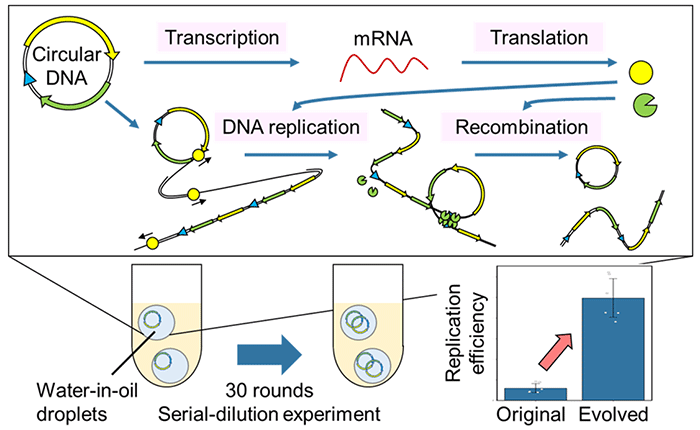Professor Norikazu Ichihashi and his colleagues at the University of Tokyo have successfully induced gene expression from a DNA, characteristic of all life, and evolution through continuous replication extracellularly using cell-free materials alone, such as nucleic acids and proteins for the first time.
The ability to proliferate and evolve is one of the defining characteristics of living organisms. However, no artificial materials with these characteristics have been created. In order to develop an artificial molecular system that can multiply and evolve, the information (genes) coded in DNA must be translated into RNA, proteins must be expressed, and the cycle of DNA replication with those proteins must continue over a long period in the system. To date, it has been impossible to create a reaction system in which the genes necessary for DNA replication are expressed while those genes simultaneously carry out their function.
The group succeeded in translating the genes into proteins and replicating the original circular DNA with the translated proteins by using a circular DNA carrying two genes necessary for DNA replication (artificial genomic DNA) and a cell-free transcription-translation system(1). Furthermore, they also successfully improved the DNA to evolve to a DNA with a 10-fold increase in replication efficiency by continuing this DNA replication cycle for about 60 days.
By adding the genes necessary for transcription and translation to the artificial genomic DNA developed by the group, it could be possible to develop artificial cells that can grow autonomously simply by feeding them low-molecular-weight compounds such as amino acids and nucleotides, in the future. If such artificial cells can be created, we can expect that useful substances currently produced using living organisms (such as substances for drug development and food production) will become more stable and easier to control.
This research has been led by Professor Norikazu Ichihashi, a research director of the project “Development of a self-regenerative artificial genome replication-transcription-translation system” in the research area “Large-scale genome synthesis and cell programming” under the JST’s Strategic Basic Research Programs CREST (Team type). In this research area, JST aims to elucidate basic principles in relation to the structure and function of genomes for the creation of a platform technology for the use of cells.
(1) A cell-free transcription and translation system
A reaction solution containing all the factors necessary for the RNA transcription from genes encoded in DNA and translation into proteins outside the cell. The present study used the reconstituted PURE system (Shimizu et al. Nat Biotechnol. 2001), composed entirely of purified, known proteins and RNA. Hence, the system is free of unknown elements. This system was developed by Yoshihiro Shimizu (RIKEN Center for Frontier Biosciences) and his colleagues in the Takuya Ueda's laboratory at the University of Tokyo.
-

Figure1. Artificial genomic DNA replication and evolution outside of the cell This system consists of a circular DNA and a customized reconstituted cell-free gene expression system of E. coli, including T7 RNA polymerase and dNTP. The circular DNA contains the phi29 DNA polymerase and Cre recombinase genes under the T7 promoter and loxP site for recombination by Cre recombinase. First, phi29 DNA polymerase and Cre recombinase are expressed through transcription and translation. Next, the expressed phi29 DNA polymerase initiates rolling-circle replication to produce a long single-stranded DNA, then synthesizes the complementary strand to produce long double-stranded DNA. Finally, the translated Cre recombinase catalyzes homologous recombination at loxP sites to reproduce circular DNA. When encapsulated this system into micro-scale droplets and continue the replication for many generations through serial dilution cycle by supplying the cell-free gene expression system, the DNA accumulate mutations to replicate more via Darwinian evolution. © 2004 American Chemical Society
Program Information
- JST CREST
- Research Area “Large-scale genome synthesis and cell programming”
- Research Theme “Development of a self-regenerative artificial genome replication-transcription-translation system”
Journal Information
Hiroki Okauchi and Norikazu Ichihashi, “Continuous Cell-Free Replication and Evolution of Artificial Genomic DNA in a Compartmentalized Gene Expression System” ACS Synthetic Biology. Published online November 15, 2021, doi: 10.1021/acssynbio.1c00430
Contact
-
[About Research]
Norikazu Ichihashi
Professor, Graduate School of Arts and Sciences,
The University of Tokyo
E-mail: ichihashibio.c.u-tokyo.ac.jp
-
[About Program]
Mutsuko Yasuda
Department of Strategic Basic Research, JST
E-mail: crestjst.go.jp
